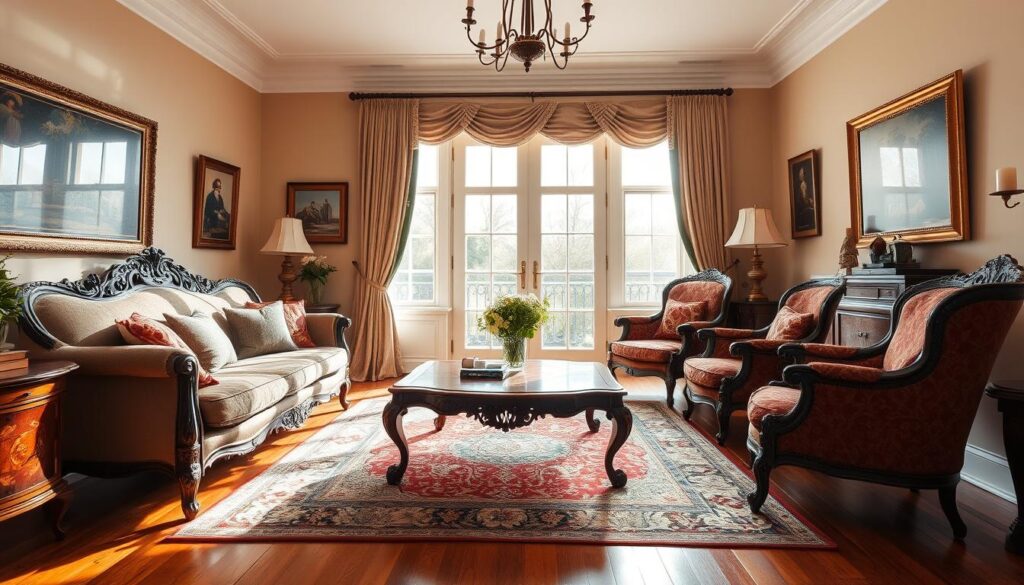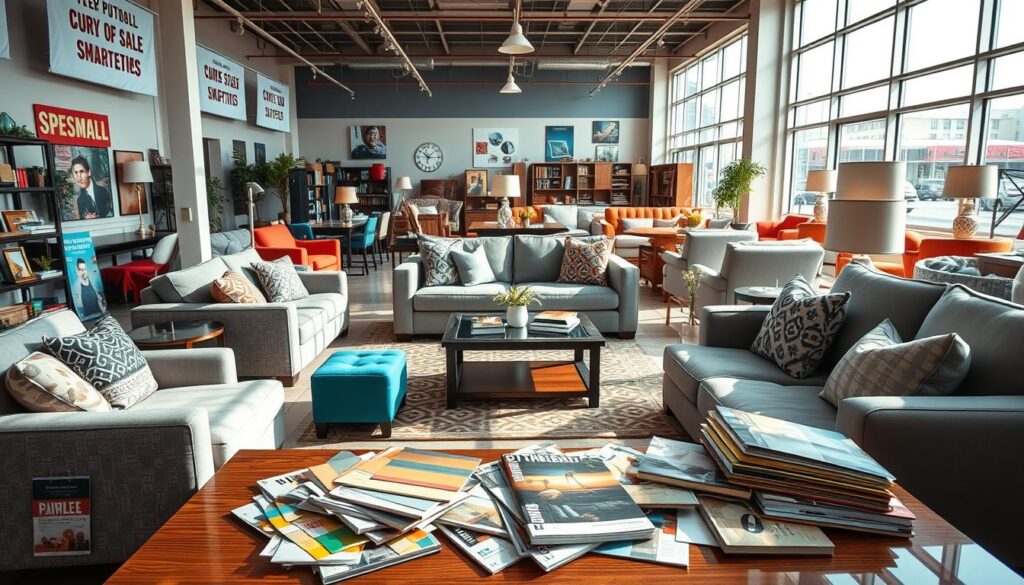Learn how to determine your interior design furniture investment and make smart choices for your home. Get expert tips on budgeting, quality assessment, and value optimization.
Creating a stunning home environment requires strategic furniture investment. Your interior design budget is key to transforming living spaces into personalized sanctuaries. Knowing how to allocate resources effectively helps you make smart choices that balance aesthetics, functionality, and long-term value. Let’s see how to determine your interior design furniture investment.
“Design is not just what it looks like and feels like. Design is how it works.” – Steve Jobs
Furniture investment is more than just buying items. It’s about choosing pieces that reflect your personal style and meet daily needs. With 78% of consumers valuing quality over quantity, smart homeowners focus on making thoughtful selections.
Navigating the world of home decor requires careful planning and informed decision-making. This guide will help you create a beautiful, functional living space that lasts.
Key Takeaways
- Prioritize quality furniture pieces that offer long-term durability
- Consider your lifestyle and daily functional requirements
- Research and compare prices across multiple platforms
- Create a realistic interior design budget
- Focus on timeless designs with versatile appeal
- Understand the importance of material selection
- Plan for future adaptability in your furniture choices
Understanding Personal Style Preferences
Discovering your personal style is key to creating a unique interior design. It shows who you are and turns a house into a home. Before you start shopping for furniture, figure out what you really like.
Research shows 57% of furniture choices are based on personal style and current decor. This highlights the need for a clear design vision before making any choices.
Identifying Your Aesthetic Vision
Your personal style reveals your character. Here are ways to find your interior design style:
- Analyze your wardrobe color palette
- Review your favorite art and design magazines
- Examine spaces that make you feel comfortable
- Reflect on your emotional response to different design environments
Exploring Popular Design Styles
| Design Style | Key Characteristics | Best Suited For |
|---|---|---|
| Minimalist | Clean lines, neutral colors | Modern urban spaces |
| Industrial | Raw materials, exposed elements | Loft-style apartments |
| Bohemian | Eclectic, colorful, layered textures | Creative personalities |
| Mid-Century Modern | Retro furniture, organic shapes | Design enthusiasts |
Creating a Style Mood Board
Make your design vision real with a mood board. A huge 72% of consumers use mood boards for a unified theme. Gather images, fabric swatches, and color samples that match your style.
“Your home should tell the story of who you are, and be a collection of what you love.” – Nate Berkus
Knowing your personal style helps you choose furniture that truly reflects you. This makes your choices more confident and satisfying.
Setting a Realistic Budget Framework
Creating a furniture budget needs careful planning and smart investment. How you allocate your costs affects your living space design. Experts say to plan your budget well, balancing your design dreams with money management.
“Smart budgeting transforms furniture shopping from a financial burden to an exciting design journey.”
When setting your furniture budget, consider these key points:
- Assess your total disposable income
- Determine percentage for furniture investment
- Prioritize essential living spaces
- Plan for long-term value
Interior design pros suggest spending 10-15% of your income on furniture and decor. This way, you invest wisely without hurting your finances. Strategic cost allocation lets you create stunning spaces while staying financially disciplined.
Here’s how to break down your furniture budget:
- Living Room: 40% of total budget
- Bedroom: 25% of total budget
- Dining Area: 20% of total budget
- Accent Pieces: 15% of total budget
By using a structured budget plan, you’ll upgrade your space wisely and affordably. Remember, choosing quality over quantity is key when picking furniture.
Assessing Your Lifestyle Needs
Choosing furniture is more than just picking something pretty. Your lifestyle is key to making your living space both functional and comfy. Design experts say 80% of the time, you should think about how furniture works.
When picking furniture, think about how you use it every day. Different lifestyles need different furniture:
Evaluating Daily Usage Patterns
- Remote workers need ergonomic home office furniture
- Those who love to entertain should look for flexible seating
- Active families should choose durable, easy-to-clean furniture
Considering Family and Pet Requirements
Choosing furniture for families and pets is important. About 85% of homeowners want furniture that’s comfy and lasts long. Think about these things when picking furniture:
- Stain-resistant fabrics for families with kids
- Furniture with rounded edges for safety
- Scratch-resistant surfaces for pet owners
Planning for Future Changes
Think about how your life might change in the future. Modular and multi-functional pieces can grow with you. With 67% of people spending a lot on furniture, choosing wisely is key.
“Furniture should evolve with your lifestyle, not constrain it.” – Interior Design Professionals
By thinking about your lifestyle and choosing functional furniture, you’ll make a space that really fits you.
How to Determine Your Interior Design Furniture Investment
Creating a smart furniture investment strategy needs careful planning. Your interior design planning should focus on selecting pieces that offer both aesthetic appeal and long-term value. Understanding how to allocate your budget can transform your living space into a functional and beautiful environment.
“Invest in quality pieces that tell a story and grow with your lifestyle.”
When developing your furniture investment approach, consider these key factors:
- Prioritize essential furniture pieces that form the foundation of your space
- Research market prices thoroughly
- Balance function with visual appeal
- Consider long-term durability
Different materials offer varying levels of investment potential. Here’s a quick comparison:
| Material | Durability | Investment Potential |
|---|---|---|
| Solid Wood | High | Excellent |
| Leather | Medium-High | Very Good |
| Metal Frames | High | Good |
Financial experts recommend allocating 30-40% of your furniture budget to critical pieces like sofas and beds. Approximately 60-70% of consumers prioritize craftsmanship over price, indicating a shift towards quality-driven purchases.
Professional advice can significantly enhance your furniture investment strategy. Consider consulting interior design experts who can provide personalized guidance tailored to your specific space and lifestyle needs.
Prioritizing Quality Over Quantity
When buying furniture, focus on quality and craftsmanship. The key to a great interior is not about having lots of items. It’s about choosing durable materials that last long.
Choosing furniture wisely can change your living space. Studies show that one or two high-quality pieces are better than many average ones. Well-planned spaces can look 20-30% more elegant and sophisticated.
Understanding Material Durability
Choosing durable materials is key for lasting furniture. Here are important factors to consider:
- Solid wood construction with strong joinery
- High-grade metal frameworks
- Premium upholstery fabrics that resist wear
- Materials that keep their shape
Evaluating Construction Methods
Craftsmanship shows in the details. Look for these signs of top-quality furniture:
- Reinforced frame joints
- Smooth, consistent finishes
- Precise woodworking techniques
- Focus on keeping the structure strong
“Quality is remembered long after price is forgotten.” – Sir Henry Royce
Researching Brand Reputation
Not all brands are the same. Look into manufacturers known for their quality and durability.
| Brand Characteristic | Quality Indicator |
|---|---|
| Warranty Length | 10+ years shows they trust their product |
| Material Sourcing | Choosing sustainable, top materials |
| Manufacturing Process | Using skilled artisans |
Even though high-quality items cost more upfront, they save money in the long run. They last longer and keep looking good.
Investing in Timeless Pieces

Creating a lasting interior design means investing in classic furniture. You want to pick pieces that stay stylish and useful for many years. Look for designs that are both versatile and timeless.
“Quality is remembered long after price is forgotten” – Aldo Gucci
When choosing timeless furniture, keep these points in mind:
- Solid wood construction using materials like oak and maple
- Superior joinery techniques such as mortise-and-tenon connections
- High-density foam cushions for optimal comfort
- Sturdy metal hardware components
A long-lasting style is not just about looks. It’s about finding pieces that are both durable and beautiful. Neutral colors like soft greys and beige are great because they fit with many decor trends.
Think about furniture that does more than one thing. For example, an ottoman with storage or a dining table that converts. These are smart choices that last.
Pro tip: Prioritize quality over quantity. A single exceptional piece can transform your entire living space.
Choosing eco-friendly options is also key. Look for FSC-certified wood and sustainable materials. These choices are good for the planet and make your furniture last longer.
- Look for warranties of 5-10 years
- Choose pieces weighing over 75 pounds for solid construction
- Select natural materials that age gracefully
By picking classic furniture that’s both versatile and durable, you’ll create a space that’s elegant and practical for years.
Space Planning and Measurement Considerations
Creating the perfect interior space needs careful planning and precise measurements. Knowing how to arrange your room can make it both functional and beautiful. Getting your measurements right is key to placing furniture well and designing your room.
Room Layout Optimization Strategies
Here are some key strategies for room layout:
- Measure your entire space accurately using a reliable tape measure
- Identify potential obstacles like windows, doors, and architectural features
- Create a scaled floor plan to visualize furniture placement
“Precision in measurement prevents costly design mistakes.”
Traffic Flow Analysis
Good spatial planning is more than just measuring. It’s also about how people move around. Experts say to keep at least 18 inches of space between furniture for easy movement.
Scale and Proportion Guidelines
Choosing the right scale for furniture is important. Here are some tips:
- Large rooms can handle bigger furniture pieces
- Smaller spaces look better with sleek, compact designs
- Balance your space by mixing different furniture sizes
By using these room layout and spatial planning tips, you can create a space that’s both functional and beautiful. Remember, 60% of homeowners wish they had measured their spaces before buying furniture. So, take your time and plan well.
Balancing Cost with Long-term Value
When picking out furniture, it’s key to see the real value of what you’re buying. Look beyond the first cost and think about the long-term benefits.
“Quality is remembered long after price is forgotten” – Sir Henry Royce
Choosing furniture wisely means looking at a few important things:
- Durability of materials
- Construction quality
- Versatility of design
- Potential longevity
Investing in furniture needs careful thought. Think about how often you’ll use it. A pricey sofa might seem like a lot at first. But when you divide the cost by how many years you’ll use it, it’s a great deal.
| Furniture Type | Initial Cost | Estimated Lifespan | Cost per Year |
|---|---|---|---|
| Solid Wood Dining Table | $2,500 | 20 years | $125 |
| Cheap Particle Board Table | $300 | 3 years | $100 |
Look into warranties and after-sales support from manufacturers. Brands with good warranties show they believe in their products. Eco-certifications like the Forest Stewardship Council (FSC) label also mean the furniture is made sustainably and will last longer.
Comparing prices at different stores can help you save money without losing quality. Keep an eye out for sales and special events. These are great times to find good deals on quality furniture.
Strategic Shopping and Timing
Furniture shopping needs smart strategies and planning. Your approach affects your budget and satisfaction with your home decor.

Seasonal Sales Opportunities
Timing is key for furniture sales. Retailers give big discounts during certain times to help you save:
- Holiday weekends like Memorial Day and Labor Day
- End-of-season clearance events
- Black Friday and Cyber Monday
- January white sales
Designer Showroom Benefits
Showroom shopping has special perks. Designers get exclusive brands and offer expert advice. They help you find pieces that fit your design vision.
Online vs In-store Shopping Comparison
| Online Furniture Stores | Physical Showrooms |
|---|---|
| Wider product selection | Ability to test comfort |
| Convenient browsing | Immediate product inspection |
| Often lower prices | Personalized design consultation |
Smart shoppers mix online and in-store strategies. Online furniture stores offer variety and convenience. Showroom shopping lets you see quality and comfort yourself.
“The best furniture purchases balance price, quality, and personal style.”
Pro tip: Keep track of prices and be ready to negotiate. Many retailers will match prices or give extra discounts during sales.
Working with Design Professionals
Interior design can be tricky. Professional designers make your home special. They do more than decorate; they make your space beautiful and functional.
“Design is not just about how something looks, but how it makes you feel in the space.” – Unknown Designer
Getting help from interior designers is key. They save you time, money, and prevent design problems.
- Comprehensive design assessment of your current space
- Access to exclusive design resources and materials
- Professional space planning and layout optimization
- Budget-conscious design recommendations
Finding the right designer is important. They charge $50 to $200 an hour. The total cost can be $2,000 to $15,200.
| Service Type | Average Cost Range | Typical Duration |
|---|---|---|
| Initial Consultation | $200 – $500 | 1-2 hours |
| Full Room Design | $1,500 – $5,000 | 2-4 weeks |
| Whole Home Design | $5,000 – $15,200 | 3-6 months |
Pro tip: Always request a detailed contract that outlines scope, fees, and expected deliverables before starting your design project.
Designers do more than give style advice. They create spaces that fit your life, budget, and style. Their help prevents mistakes and makes your home truly yours.
Maintenance and Care Investment
Looking after your furniture is more than just buying it. Good care and maintenance can make your furniture last longer. This saves you money and keeps it looking great for years.
“Quality furniture is an investment that requires thoughtful care and attention.”
Different materials need different care. Solid wood, like oak, cherry, and walnut, is very durable. With the right care, it can last for decades.
- Dust wooden surfaces regularly to prevent scratch-causing dirt build-up
- Use coasters and placemats to protect against moisture and heat damage
- Shield furniture from direct sunlight to prevent color fading
- Invest in specialized cleaning supplies for specific materials
Upholstery also needs careful attention. Leather and microfiber are very durable. Leather lasts a long time, and microfiber is great at resisting stains. Professional cleaning and treatments can make your furniture last even longer.
| Material | Maintenance Level | Estimated Longevity |
|---|---|---|
| Solid Wood | Moderate | 30-50 years |
| Leather | High | 20-25 years |
| Microfiber | Low | 10-15 years |
Consistent, proactive care is essential. By taking the time to look after your furniture, you’re not just keeping it looking good. You’re also protecting a valuable investment in your home.
Conclusion
When planning your interior design, remember it’s more than looks. Your furniture choices should match your style, be useful, and last long. Studies show 85% of buyers like furniture that does more than one thing. This helps your space grow with you.
Optimizing your space is key. With 50% of layouts improving function, measuring and placing furniture wisely is essential. Think about how each piece fits into your home. Choosing eco-friendly and secondhand items adds character and supports your values.
Your home should show who you are and what you need. Focus on quality, understand your space, and make smart choices. This way, your home will be beautiful and functional. Whether you’re on a tight budget or splurging, aim for a space that’s both cozy and uplifting.
Interior design is a journey, not a one-time task. Be open to changing your style, try new things, and mix affordable and pricey items. Your home is a canvas that evolves with you.


